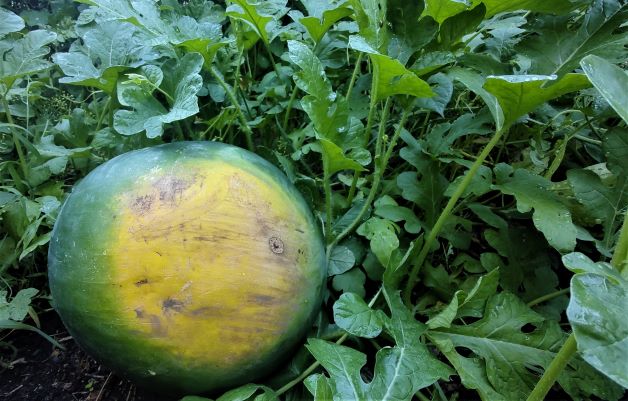Choosing Watermelons

August brings us to the heart of watermelon season. Depending on the year’s growing conditions and how long we avoid frost, watermelon can be harvested from mid-July to mid-October. So, how do I choose a good one?
You may find numerous “home solutions” for choosing the perfect watermelon by browsing social media pages. You’re likely looking for a sweet, juicy, and ripe fruit with minimal seeds. But how do you know which is ideal without cutting it open or tasting it? And how reliable are those home solutions?
Many of the home solutions you may see include looking at the webbing of the rind on the melon or even “thumping” a melon to listen for a dull thud. While these practices are valid in certain instances, they vary based on the variety of watermelons you inspect. With over 300 watermelon varieties grown in the United States… this can leave much to be desired.
The most reliable method of inspecting a watermelon for ripeness is by looking at the color of the ‘ground spot’ of the melon, where the webbing and chlorophyll are absent due to the fruit lying on the ground. The rules of inspection: ground spots of striped melons should be a buttery yellow. Ground spots of green melons should be a deep yellow. And light green melons should have a light-yellow spot. A white ground spot means it’s not ripe yet and likely has little flavor.

If you happen to be growing your watermelons instead of purchasing them, there is another sign to look for – the vine tendrils that attach the berry to the rest of the vine will be dried out.
If you know the variety of watermelon you have planted, the days to maturity indicated for that variety will be a good starting point for understanding when your fruit is near ripeness. Many watermelon varieties require around 85 days, or two and a half months, to develop their fruit fully. If you planted in early June, expect an August harvest, with the reminder that temperatures above 95 degrees Fahrenheit or below 50 degrees Fahrenheit may have slowed development.
Also, watermelon crops depend heavily on pollination, and not all pollination happens at once. This means that your watermelon plants will produce several harvests throughout the season. The best bet for calculating ripeness: you are trying to estimate the days of maturation since the flower was pollinated. However, if you don’t happen to be watching your garden under a microscope, the tried-and-true ground color spot test is still there.
Anthony Reardon, Horticulture and Small Farms Agent, 2023
Have questions?
The Garden Hotline is staffed by trained EMG volunteers and Extension staff who will assist you with questions.
Phone: (913) 715-7050
Email: garden.help@jocogov.org